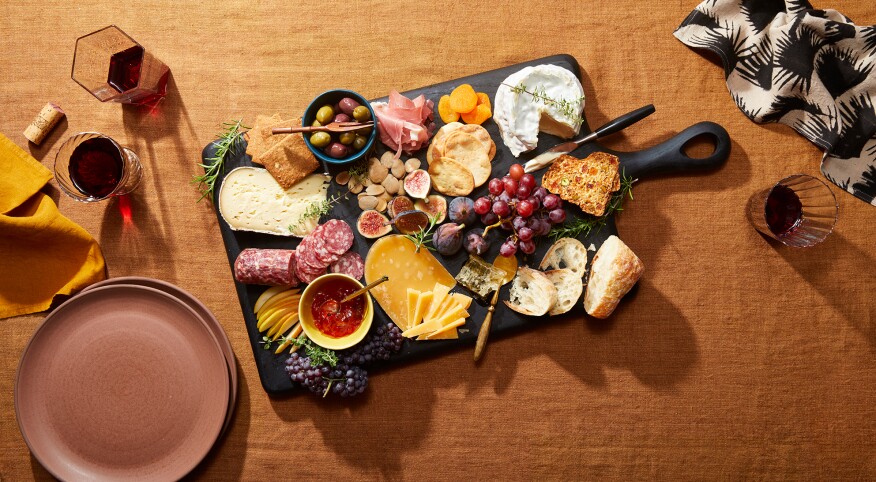One of my family’s most requested Sunday lunches is a charcuterie board. And judging from my social media feeds, we are not the only ones craving these beautiful platters of assorted goodies.
Technically, charcuterie is defined as “a delicatessen specializing in dressed meats and meat dishes, or the products sold in such a shop.” Pronounced shahr-ku-te-REE, it is derived from the French words for flesh (chair) and cooked (cuit).
But like many people, our family uses the term loosely. While I usually include meats, our platters are also filled with assorted goodies such as cheeses, breads, fresh and dried fruit, olives, nuts, jams and, on occasion, gummy bears.
Suzanne Lenzer, food stylist and author of the book Graze, says, “I think these platters have gained popularity because people are more interested in conversing and having little bites together than eating a big meal.” There is minimal cooking involved, and the ingredients can be altered based on what you have on hand and the palates of your guests.
Lenzer adds, “With platters, it’s about quality versus quantity. So, the host can buy what they can afford and only needs a small amount of each item.”
Although there are no real rules for making a delicious charcuterie platter, here are some suggestions for inspiration.
It starts with the platter
Charles Duque, managing director of Americas for CNIEL [French Dairy Board] based in New York, says, “The board itself — wood, marble, stone or slate — is part of the presentation. Dark-colored boards make the cheese stand out. I always like to cut into the cheese and place a knife per cheese to avoid flavor transfer or blue mold on my triple crème!”
Make sure the platter is big enough for items to not spill off but small enough that it looks plentiful.
Lenzer says, “Layer the components together to create a plate that feels romantic and cluttered, but organized, too.”
With COVID-19 concerns, sharing a giant platter between a group of people may not seem responsible. Lenzer says, “I recently entertained two other couples in my yard. We all sat 6 feet apart, and I created three small identical platters — for each couple to enjoy individually. It looked adorable and felt more sanitary.”
Say cheese
Duque thinks that using a variety of cheeses in different textures and colors makes for a visually exciting board. He suggests using an odd number of cheeses (three, five, seven, etc.) and including that mix of colors and textures — creamy, soft-ripened, harder cheeses, washed-rinds, bleus, etc. Duque suggests arranging the cheeses on the board from “mild to wild,” because “that way, your palate will be able to savor each cheese as they increase in intensity.”
While cheeses like Brie, Gouda and Cheddar are standard choices, consider more out-of-the-box options — such as Comté, a French cheese made from unpasteurized cow’s milk, or sheep’s milk cheeses. Lenzer is a fan of the artisan cheesemakers in the U.S., including Vermont Creamery, Jasper Hill and Cowgirl Creamery, as well as the extensive cheese section at Costco.
Choosing meats
For a real charcuterie, pick a few types of meat to serve alongside your cheeses. Salamis and prosciutto are popular, but don't be afraid to experiment with other options. Lenzer says, “Bresaola and coppa are both underrated and delicious. I used to have to go to specialty stores to purchase, but now many local shops and supermarkets are carrying.”
Add flavors
After picking the cheeses and meats, add in accompaniments such as fresh and dried fruits, nuts, crackers, jams, olives and other items. Choose flavor profiles that complement each other. Duque explains, “For example, some people find bleus too pungent, but if they drizzle a bit of honey, it changes the entire experience.”
Don’t be afraid to experiment and add on out-of-the-ordinary items. Some of Lenzer’s favorites include Marcona almonds, blood orange compote, rainbow radishes, and marinated artichokes. She says, “I like serving foods people wouldn’t normally think to buy for themselves but are delicious. I also like an element of surprise — something as simple as yellow raspberries, instead of red.”
Make it pretty
Since we eat with our eyes first, make your platter eye-catching. Consider varying the colors on the plate or picking a color/seasonal theme. Lenzer says, “In the summer, I like plates with yellows and greens, so I will serve kiwis, dried orange crisps, kumquats and pineapple. In the fall, reds and burgundy look festive. Red grapes, currants, cranberries and figs taste great and look beautiful alongside charcuterie meats.” One of Lenzer’s favorite presentation tricks is to slice a whole pomegranate and serve half. She says, “It is fabulous next to a block of white cheese.” Sprigs of fresh herbs such as rosemary or thyme are great as finishing touches on the platter.
And then enjoy
Again, when it comes to the charcuterie craze, there are no real rules. You don’t even need to serve meat (or cheese) to hop on the platter trend.
Says Lenzer, “I don’t subscribe to the view that you need to drink white wine with fish and red wine with meat. I think you should drink what you love. Same with platters; there are no must-dos. Just serve delicious, simple food that looks pretty and that you enjoy eating.”

Tara Donne









